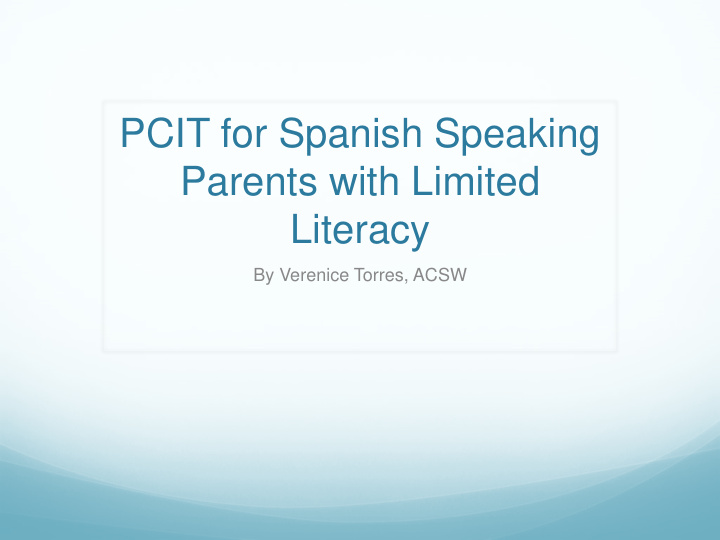



PCIT for Spanish Speaking Parents with Limited Literacy By Verenice Torres, ACSW
How illiteracy impacts PCIT? Intake Cultural Values Reviewing comprehensive measures for a better understanding (Measures: ECBI, PSI, CBCL) Teach Sessions Heavily depend on handouts as aides and reference for the caretaker Coaching Sessions Require the completion of a WACB prior to each session Homework Sessions Is a requirement to be completed daily and submitted at each session
Cultural Modifications Given that the term Hispanic is meant as an umbrella term to encompass different subgroups, it is important to understand different cultural relevant values that apply to different subgroups (Borrego et al., 2006) . Respeto (i.e., respect) is important to Hispanics and this was displayed by showing deference toward the caretaker (addressing /him/her in a formal usted vs. an informal tu when speaking with him/her). Personalismo (developing a warm professional relationship with the caretaker) Simpatia (engaging in positive social interactions with others). Example by not only showing interest and asking how he/she and the child were doing but also inquiring how the rest of their family was doing as well. Cariños literally means using terms of endearment for the child (e.g., Nena/Nene). Cariños can serve as social reinforcers and they can be incorporated when teaching the parent to verbally praise prosocial behaviors .
Measures Bernal et al. (1995) noted that language is an essential component of adapting psychosocial interventions to be culturally sensitive for Hispanic children and families Discuss the logistics of PCIT It is important to ask caretaker about any barriers prior to the beginning of treatment Families may need other supports before beginning treatment The therapist can use the treatment session checklist that monitors attendance and intervention completion tasks and discuss any barriers Review measures (ECBI, CBCL, PSI) Assist caretaker to complete forms
Teach Session Provide the handouts Read each form to caretaker Provide examples for each strategy Role play with caretaker to make sure he/she understands the skills Use visuals (videos) Focus on one skill at a time An approach that emphasizes modeling of skills lends itself well to families that may have a difficult time reading materials and applying concepts if they are only explained verbally (Borrego et al., 2006)
Coach Session Be able to set a specific time to complete WACB Ex. (Approx. additional 5-10 mins prior to sessions) Supportive Communication The first stage of PCIT aims to increase positive interactions between the parent and the child in addition to teaching differential attention skills Feedback is essential to help support caretaker in the transition between stages of PCIT Increasing treatment frequency may help caregivers learn and maintain skills more effectively (Stokes et al.,)
Homework Homework Sessions Identify a person to assist caregiver complete homework Modify/adapt the homework sheet to assist caregiver complete the homework May be helpful to incorporate problem solving strategies as a way to assist in effectively managing and increasing self- efficacy in completing homework Homework completion has also been linked to decreases in parenting stress, improvements in parenting skills, decreases in child behavior problems, and reductions in the number of sessions needed to reach CDI mastery (Stokes et al.,)
Impacts Illiteracy creates barriers to succeed in PCIT It has been suggested that the prevalence of mental health problems for children from ethnic minority or low-income families ranges from 34% to 50% (Borrego et al., 2006)). Childrearing and parenting practices in Hispanic communities are greatly influenced by culture and other factors (Borrego et al., 2006).
Citations Parent-Child Interaction Therapy With a Spanish- Speaking Family. Borrego, J., Anhalt, K., Terao, S., Vargas, E., & Urquiza, J. 2006. https://pcit.ucdavis.edu/wp- content/.../BorregoAnhaltTeraoVargasUrquiza20062.pdf Stokes JO, Jent JF, Weinstein A, et al. Does practice make perfect? The relationship between self-reported treatment homework completion and parental skill acquisition and child behaviors. Behav Ther. 2016;47(4):538–549. [PubMed]
Recommend
More recommend